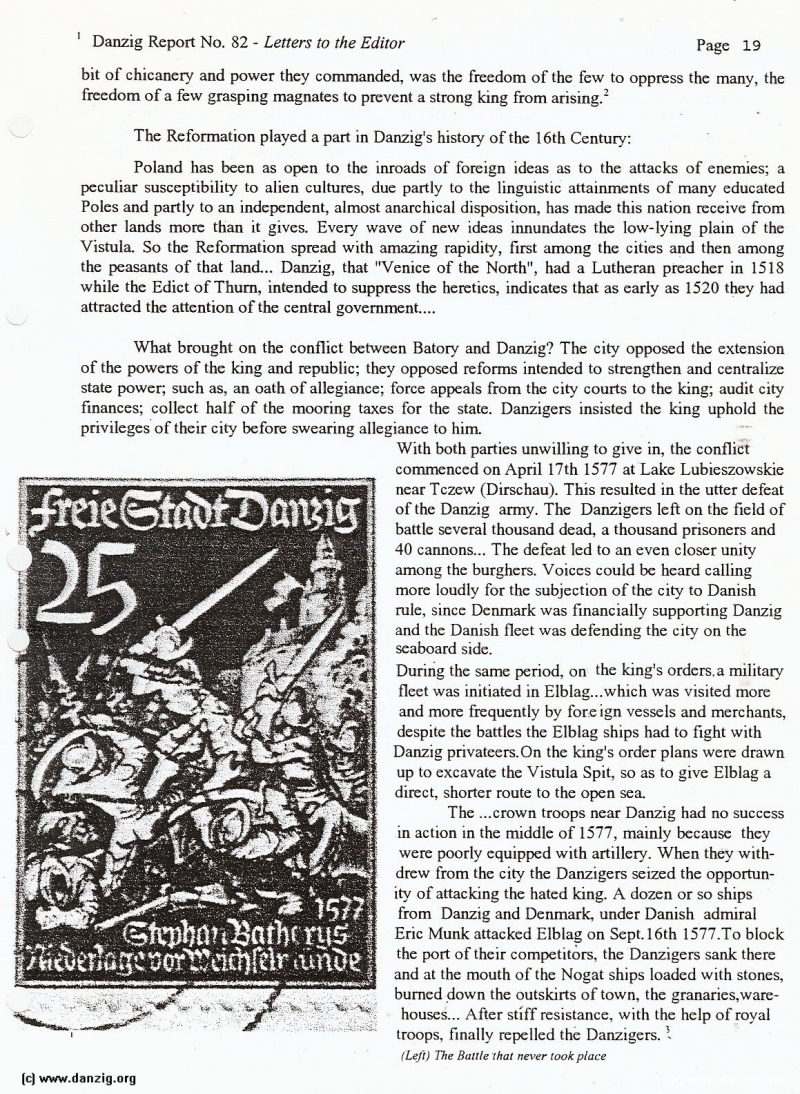
bit of chicanery and power they commanded, was the freedom of the few to oppress the many, the freedom of a few grasping magnates to prevent a strong king from arising.2
The Reformation played a part in Danzig’s history of the 16th Century:
Poland has been as open to the inroads of foreign ideas as to the attacks of enemies; a peculiar susceptibility to alien cultures, due partly to the linguistic attainments of many educated Poles and partly to an independent, almost anarchical disposition, has made this nation receive from other lands more than it gives. Every wave of new ideas innundates the low-lying plain of the Vistula. So the Reformation spread with amazing rapidity, first among the cities and then among the peasants of that land... Danzig, that “Venice of the North”, had a Lutheran preacher in 1518 while the Edict of Thurn, intended to suppress the heretics, indicates that as early as 1520 they had attracted the attention of the central government....
What brought on the conflict between Batory and Danzig? The city opposed the extension of the powers of the king and republic; they opposed reforms intended to strengthen and centralize state power; such as, an oath of allegiance; force appeals from the city courts to the king; audit city finances; collect half of the mooring taxes for the state. Danzigers insisted the king uphold the privileges of their city before swearing allegiance to him.
With both parties unwilling to give in, the conflict
commenced on April 17th 1577 at Lake Lubieszowskie near Tczcw (Dirschau). This resulted in the utter defeat of the Danzig army. The Danzigers left on the field of battle several thousand dead, a thousand prisoners and 40 cannons... The defeat led to an even closer unity among the burghers. Voices could be heard calling more loudly for the subjection of the city to Danish rule, since Denmark was financially supporting Danzig and the Danish fleet was defending the city on the seaboard side.
During the same period, on the king’s orders.a military fleet was initiated in ElbIag. . .which was visited more and more frequently by for.e ign vessels and merchants, despite the battles the Elbiag ships had to fight with Danzig privateers.On the king’s order plans were drawn up to excavate the Vistula Spit, so as to give Elblag a direct, shorter route to the open sea.
The . .. crown troops near Danzig had no success in action in the middle of 1577, mainly because they were poorly equipped with artillery. When they withd rew from the city the Danzigers seized the opportuni ty of attacking the hated king. A dozen or so ships
from Danzig and Denmark, under Danish admiral Eric Munk attacked ElbIag on Sept.I6th l577.To block the port of their competitors, the Danzigers sank there and at the mouth of the Nogat ships loaded with stones, burned down the outskirts of town, the granaries, wareh ouses... After stiff resistance, with the help of royal troops, finally repelled the Danzigers.
Danzig Report Vol. 1 - Nr. 82 - January - February - March - 1994, Page 21.
Hits: 1539
Added: 06/07/2015
Copyright: 2024 Danzig.org

